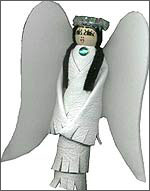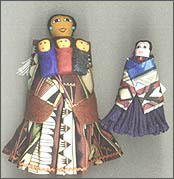Home
About Us
Current News
Event Calendar
Artist Bios
ARCHIVES
Display IDEAS
Collecting Tips
Gen Arts/Crafts Info
Testimonials
Hours/Directions
Online Store
ARCHIVES - Artist / Highlight of the Month
ELSIE BURNS NELSON & WILIAM NELSON - May 2003
The Highlight of the Month program at The Indian Craft Shop focuses on a particular craft area, region or artist family/group. Our aim is to illustrate the diversity of tribal groups and the wide variety of artistic expressions and traditions in the country today.

Elsie Burns Nelson and her son William Nelson are two innovative dollmakers whose works delight both children and adults. Elsie began her craft more than 35 years ago. While growing up in Cowspring, Arizona, she learned from her grandmother how to use colorful velvet scraps to make cloth dolls wearing the same traditional Navajo style velvet blouses and tiered skirts worn by themselves. The skirts are often called "broomstick skirts" because they would be twisted around a broomstick to get the full-pleated effect.
Elsie married Willie Nelson and moved to To'hajiilee, New Mexico (formerly known as Canyoncito), where he lived. Together they raised their two sons, Wallace and William. Willie is a silversmith, and both sons follow in this tradition of classic-style silver jewelry set with coral and turquoise and embellished with twisted wire.
But, William also joined his mother in her dollmaking. "One of my first memories as a child is helping my mother make her dolls," says William. "I enjoyed cutting out the patterns and putting them together. By the time I was 10 years old, I joined other Navajo artists who sold their work along the highway to tourists."
Working, as they have for years, on an old featherweight Singer sewing machine, Elsie and William started with a pattern used by Gertie, their great grandmother's mother. From this simple pattern, they've made a number of variations. "We like to use the cotton prints with Southwest designs, but have difficulty finding them," says William. "We also use the traditional velvets, as well as silks and other materials." The hair may be braided or tied back in the customary Navajo way. The grandmother dolls have silver and black hair.

They added a "story doll" to their collection. "Some people call them storyteller dolls because they hold from one to eight babies in their arms. But we call them 'story dolls' because we don't want to offend the Pueblo artists who make the clay storytellers. However, our traditions also include the telling of stories and passing of traditions orally from the elders to the young.
The sculptural quality comes from a hollow-form technique I fashioned to give a three-dimensional look to my inlay work," says Maktima. It's not unusual to see a thin band of gold used as an accent in his channel inlay to enhance the stone. Many pieces, like his Mimbres animal pins, combine reticulated silver with brushed silver to give texture and added dimension to his overlay.
Their art has kept this mother and son close. "We hope that our dolls bring joy to whoever buys them. The bright colors and happy faces give children a new way to look at our culture. Our dolls are a miniature of our People today. We still wear these styles and make the broomstick skirts and blouses for our family, and also sell them locally. Our dolls are a gentle reminder that we are still here."
©The Indian Craft Shop 2003


